Signature Analyzer
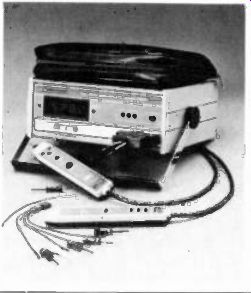
The B&K-Precision product group of Dynascan Corporation has recently announced its new model SA-1010 Sig nature Analyzer. The new instrument is designed to simplify and reduce the cost of troubleshooting complex digital and microprocessor-based products. The SA-1010 reportedly allows semi-skilled technicians to troubleshoot microprocessor-based products down to the component level, by making simple comparisons of "digital signatures." And, instead of the common practice of swapping boards in the field to locate a suspected problem, the field engineer can use the SA-1010 to localize the problem and replace only the board or components found to be defective. When the data probe of the SA-1010 is applied to a circuit node, the instrument converts the lengthy bit stream present into a unique four-digit hexi-decimal type display. To locate a problem, the field engineer traces through the circuitcom paring the observed signatures to those identified on a schematic diagram or service manual of the product under test.
When a node is reached that has a correct input signature and incorrect output signature, the problem has been isolated.
For a fast field check of the board only, signatures can be observed at the board interconnection points and compared with data in a simplified field test procedure. The SA-1010 is a multi-family instrument, usable with TTL, MOS and CMOS logic circuits. For user convenience, a 1MHz TTL clock synchronizing output is featured on the rear panel. The instrument is supplied with detachable probe assembly, control and data pods, and vinyl pouch for storage of probes and manual.
Digital Power Source
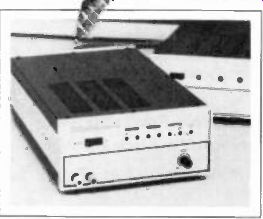
A new digitally programmable power source for use with automatic test equipment, exercisers, measurement systems and diagnostic equipment is available from Kikusui International Corporation, a subsidiary of Kikusui Electronics corporation. Called the Model DPSV 20-1, this new instrument provides a bi-polar, constant voltage output of - 20v to + 20v at 0.05a to 1a.
It features an accuracy of 0.05% and a response time of 500 µS from minus to plus full scale. The 20-1 incorporates a unique design that includes the DAC, high accuracy power supply and binary interface circuitry in a single integral package. This is in contrast to most manufacturers who treat DPSs as hybrid systems with the problems of mixing and matching two or more "black boxes." This multiple black box design of a DAC and standard off-the-shelf power supply requires multiple "power on" circuits that can introduce spikes and incremental startup time lag. It also requires interconnect cabling that con tributes to EMI, copper loss and noise.
The 20-1 can be programmed to respond to a wide range of control signals such as polarity, strobe, data clear, range, direct zero, address, standby, set, direct standby and output voltage.
It will also provide status signals including address valid, data accepted, over-data, range incorrect, thermal down, ready and current limit. For IEEE bus applications, Kikusui offers an interface device that will control up to fifteen power sources. A fully programmable read/write controller and a manual controller/exerciser also are available. In addition to the 20-1, there are fourteen other models in the line including current programmable and voltage programmable series in voltage ranges from 0 to 100 v and with current capacities from 0.02 to 5 amps.
Logic Probe Tester
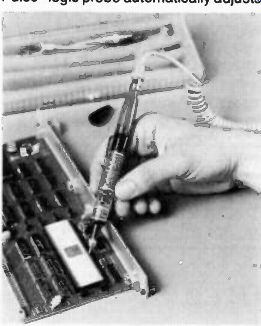
The new Model 205 "Catch-A-Pulse" hand-held logic probe and Model 205 K kit, recently introduced by the Triplett Corporation, provides a means of analyzing and troubleshooting logic gates and sequential circuits such as flip flops, counters, registers and microprocessors. The probe is similar in size to a felt-tip marker pen and has a shirt pocket clip. It provides a visual (LED) display of Hi, Lo, pulsing or open circuit logic probes, which are referred to on the probe's Truth table. The "Catch-A Pulse" logic probe automatically adjusts to the proper DTL, TTL, MOS, CMOS or Microprocessor circuit thresholds when its leads are connected to the IC circuit power supply. Power supply reverse polarity protection is also provided. The input impedance of the probe's tip becomes a slave to the circuit under test, causing it to react to whatever signal or logic condition is present. The probe's memory automatically resets every 50 microseconds to observe and display another pulse. The Triplett "Catch-A-Pulse" logic probe circuitry has built-in current limiting for intermittent or low duty cycle over-voltages. The Model 205 "Catch-A-Pulse" comes complete with one year warranty, detachable 6 ft. coiled cord with mini-alligator clips, instruction manual and clear plastic carrying case.
Digital Multimeter Probe
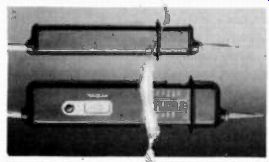
The Digi-Check from Energy Electronic Products Corp., is a 3 1/2 digit hand-held multimeter consisting of two probe tips connected by a lead. The hand units are basically the same size as conventional probe tips. They contain the instrument with digital display, a power supply with IC battery charger, and the test lead. Specifications include a dc voltage range of 0.1mv to 500v, an ac voltage range of 10mv to 500v, resistance measurement from 0.1 ohm to 20 meg, automatic polarity indication and auto zero.
Hand Held Power Meter
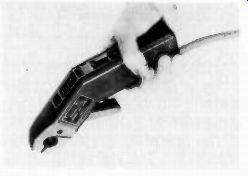
F.W. Bell, Inc., has recently introduced a new Hall effect power meter that reads real power on circuits from dc to 1kHz to 199.9kw and to 150 a (to 300 a with slightly reduced accuracy), and with a range to 480vac and 600vdc. Fully port able, the new meter, Model PC200D, has a three-and-a-half-digit LCD and automatic decimal shift. The PG200D may be used on conductors up to 3/4-in. in diameter. It utilizes the pistol shape of Bell's hand-held current meters, and weighs 1 lb.
Power Line Noise Detector
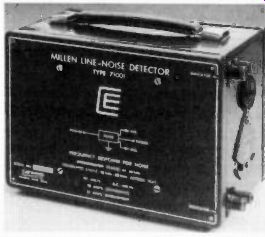
A portable test instrument, formerly manufactured by Millen, for detecting power line noise interference and verifying when the problem has been corrected has recently been introduced by Caywood Electronics, Inc. The Millen Type 71001 Power Line Noise Interference Detector is a passive, portable test instrument that helps determine if EMI/ RFI noise problems are coming in on the ac or dc power line, or being generated by some device on the line. Used with an oscilloscope or panel-meter equipped radio receiver, it can also be used to confirm that the noise problem has been corrected. Sensitive only to EMI/RFI noise on power lines, the 8 in. H x 6 in. W x 11 in. L, 11 lb. Millen Type 71001 Power Line Noise Interference Detector incorporates a damped filter that rings slightly allowing pulses to show up on a narrow band oscilloscope. The sensing elements in the filter are not traversed directly by line current, and are immune to saturation effects that could distort results.
Miniature Soldering Station
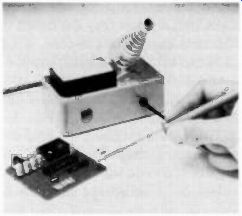
A new miniature soldering station from Wahl Clipper Corporation operates on 6w (ac), allowing for safe soldering on miniature circuits and instruments as well as on heat-sensitive components.
The model 7230 is suited for production line operations, or anywhere where fine, close work is required. Principal performance features of the 7230 station include a double-insulated transformer, a tip-cleaning sponge, sponge well, spring holder, indicator lamp and internal safety fuse. Fourteen tips from 1/25 to 5/32 in. are available, and can be interchanged quickly without special tools. Tips cool down fast from 360°C, and resist seizure. A 6w iron similar to the 7230's is offered separately. The model 7240 iron has a 4-ft pigtail which connects to a transformer on an ac or dc power source. With a variable power source, the 360°C temperature can be lowered for special applications. A 3/32 in. tip is standard, but many shapes and sizes are available.
True RMS Analog Voltmeter
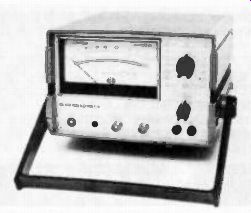
The Model MV-800 Analog Voltmeter from IET Labs, Inc. is a true RMS instrument and will therefore accurately present the effective power of wave forms which depart from a true sine wave. Fifteen ranges are provided from 30p.v full scale to 300v, and from -90 dB full scale to +50dB in decades.
Readings as low as -105dB are there fore accomplished. A front panel band width switch permits a choice of wide band measurements, standard first order audio bandpass (20-20kHz) or "External Filter." A group of standard custom plug-in filter modules are available from IET. The Model MV-800 can be used as an oscilloscope preamplifier through the use of its front panel BNC output jack. A chart recorder, DVM, X Y plotter, etc. may be connected to the rear BNC connector for permanent records of readings or "under-over limits" observations. This terminal provides a linear dc output of 0-1 volt proportional to meter deflection. Due to its internal Nicad battery pack, the Model MV-800 may be totally isolated from the power line and external grounds. Ground loop problems are therefore minimized, and measurements can be made at or near the power line frequency without "beating" when using sensitive scales. The unit may be used on the ac line during battery recharging and a "BATTERY TEST" position on the range switch reads battery condition. An LED indicates the requirement to recharge batteries before they have become discharged to a point which causes erratic readings.
Tool Case
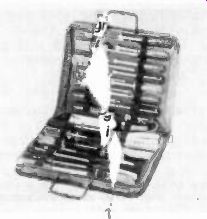
Vaco Products Company's new Tool Bvx Super Case No. 70470, has recently been introduced. This new tool case contains a selection of 29 professional hand tools in a vinyl zipper case with retractable handles for easy carrying.
The assortment of tools includes a variety of screwdriver … allow shaft nut drivers, wiring and crimping tools, electrical testers, and special problem solving tools such as an magnetic screwdriver, spring tool, adjustable plier, hex key wrench set, and convertible snap ring plier. Each tool is held by a heavy duty elastic band which makes it easy to re move the tools, yet holds them in place.
The combination of a broad representation of the Vaco tool line and a light weight case makes the Tool Bvx Super Case useful as a distributor salesman's sample case, as a serviceman's case, or for use around the home.
TV Bar/Dot Mixer

The Signal Source 1207 from Visual In formation Institute superimposes precise patterns (Bar, Dot, H Bars and V Bars) on a composite video signal for complete TV service and setup. The BAR pattern is useful in setting up proper deflection size and linearity of monitors or other display devices. Control of BAR width and spacing permits pattern to be used as a reference grid overlay for exacting measurements. The DOT pattern is used universally with the EIA Linearity Chart 1961 to set and check camera tube linearity. This pat tern may also be used as a reference overlay on the normally televised image. The 1207 is designed for portable laboratory or field use with carrying handle. It is also available in a rack-mount cabinet for inclusion into TV equipment installations.
(source: Electronic Technician/Dealer)